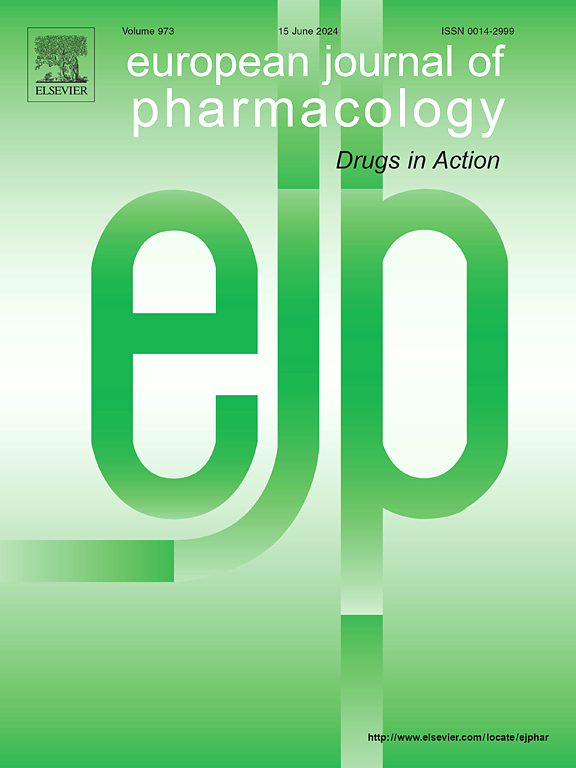Activation of the Nrf2 pathway by a novel bipyrazole compound mitigates doxorubicin-induced cardiotoxicity in Wistar albino rats
IF 4.2
3区 医学
Q1 PHARMACOLOGY & PHARMACY
引用次数: 0
Abstract
Background
Doxorubicin (DOX) clinical utility is limited by its dose-dependent cardiotoxicity. This study aimed to evaluate the cardioprotective potential of 2′,3,3,5′-Tetramethyl-4′-nitro-2′H-1,3′-bipyrazole (TMNB) in a rat model of DOX-induced cardiac injury.
Methods
Rats were divided into control, DOX, TMNB, and TMNB + DOX groups. TMNB was administered for 14 days. A single dose of DOX was given on day 7. Serum, oxidative stress, cytokines, apoptosis markers, and Nrf2 pathway gene expression were assessed. One-way ANOVA followed by Tukey's post-hoc test were used.
Results
TMNB pretreatment reduced CK-MB and LDH levels by 42.9 % and 50 %, respectively (Cohen's d > 6.4, p < 0.001). Histologically, TMNB significantly reduced myocardial damage (d = 6.63). MDA levels declined by 45.1 % in TMNB-treated rats (d = 7.18), while antioxidant enzymes SOD and CAT increased by 99.4 % and 74.1 %, respectively (p < 0.001). TMNB restored GSH and GPx-1 levels, reversing DOX-induced oxidative depletion (all d > 4.7). Pro-inflammatory cytokines TNF-α and IL-1β were reduced with TMNB pretreatment by over 40 % (d > 9.3, p < 0.001). Similarly, TMNB significantly downregulated NF-κB gene expression (d = 9.46). Caspase-3 and Bax were reduced by 44.9 % and 65.5 %, respectively (p < 0.001), while Bcl-2 expression was restored. TUNEL staining confirmed reduced apoptosis (d = 11.20). TMNB increased Nrf2, HO-1, and NQO1 expression (Nrf2 d = 8.21) while decreasing Keap1 (p < 0.0001).
Conclusion
TMNB significantly mitigates DOX-induced cardiotoxicity likely via Nrf2 pathway activation. These findings support TMNB's potential as a cardioprotective adjunct during chemotherapy, warranting further investigation in chronic and clinical models.
一种新型联吡唑化合物激活Nrf2通路可减轻阿霉素诱导的Wistar白化大鼠心脏毒性
多柔比星(DOX)的临床应用受到其剂量依赖性心脏毒性的限制。本研究旨在评估2 ',3,3,5 ' -四甲基-4 ' -硝基-2 ' h -1,3 ' -联吡唑(TMNB)在dox诱导的大鼠心脏损伤模型中的心脏保护作用。方法将大鼠分为对照组、DOX组、TMNB组和TMNB + DOX组。给药14天。第7天给予单剂量DOX。评估血清、氧化应激、细胞因子、凋亡标志物和Nrf2通路基因表达。采用单因素方差分析和Tukey事后检验。结果stmnb预处理使CK-MB和LDH水平分别降低42.9%和50% (Cohen’s d >;6.4, p <;0.001)。组织学上,TMNB显著减轻心肌损伤(d = 6.63)。tmnb处理大鼠MDA水平下降45.1% (d = 7.18),而抗氧化酶SOD和CAT分别升高99.4%和74.1% (p <;0.001)。tmmb恢复GSH和GPx-1水平,逆转dox诱导的氧化消耗(all d >;4.7)。经TMNB预处理后,促炎细胞因子TNF-α和IL-1β降低40%以上(d >;9.3, p <;0.001)。同样,TMNB显著下调NF-κB基因表达(d = 9.46)。Caspase-3和Bax分别减少44.9%和65.5% (p <;0.001), Bcl-2表达恢复。TUNEL染色证实细胞凋亡减少(d = 11.20)。TMNB增加了Nrf2、HO-1和NQO1的表达(Nrf2 d = 8.21),降低了Keap1的表达(p <;0.0001)。结论tmnb可能通过激活Nrf2通路,显著减轻dox诱导的心脏毒性。这些发现支持TMNB在化疗期间作为心脏保护辅助剂的潜力,值得在慢性和临床模型中进一步研究。
本文章由计算机程序翻译,如有差异,请以英文原文为准。
求助全文
约1分钟内获得全文
求助全文
来源期刊
CiteScore
9.00
自引率
0.00%
发文量
572
审稿时长
34 days
期刊介绍:
The European Journal of Pharmacology publishes research papers covering all aspects of experimental pharmacology with focus on the mechanism of action of structurally identified compounds affecting biological systems.
The scope includes:
Behavioural pharmacology
Neuropharmacology and analgesia
Cardiovascular pharmacology
Pulmonary, gastrointestinal and urogenital pharmacology
Endocrine pharmacology
Immunopharmacology and inflammation
Molecular and cellular pharmacology
Regenerative pharmacology
Biologicals and biotherapeutics
Translational pharmacology
Nutriceutical pharmacology.

 求助内容:
求助内容: 应助结果提醒方式:
应助结果提醒方式:


